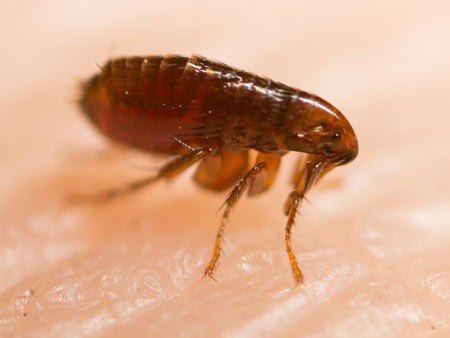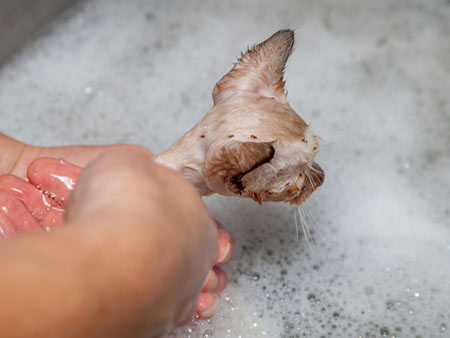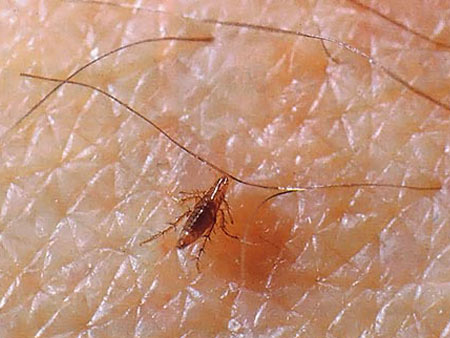


On The Rebound, Theories Abound Regarding The Resurgence Of Flea Calls
By Lisa Lupo, Pest Control Technology, July 2006
It’s a fact that fleas are reemerging across most of the U.S., but it’s pure speculation as to why this is happening. Ten to 15 years ago, fleas were a significant piece of business for most residential pest control companies. Then in the 1990s on-pet application with actives such as fipronil, imidacloprid and the IGR methoprene, were introduced, due in part to the research of Dr. Michael Dryden, professor of veterinary parasitology at Kansas State University (KSU). Dryden and others found that dog- and cat-infesting fleas cannot survive apart from their host and need constant host relationship for reproduction. The breakthrough, says Dryden’s KSU website, led to the development of topical and systemic flea treatments “which can be applied directly to the pet without having to treat its environment.”
As a result, the slice of the service pie allocated to the pest management industry steadily shriveled to virtually nothing. It stayed that way for years, with companies getting calls now and again for fleas, but veterinarians and their on-pet products taking over the bulk of the business. Gradually pest management companies quit training on flea treatments; flea products disappeared from inventory; and a generation of service technicians was raised with no flea service experience.
Even the Ninth edition of the Mallis Handbook of Pest Control, a virtual bible for PSOs, stated, “In the last decade, flea control products killing virtually 100% of on-host populations have been developed…Using these host-targeted products has minimized the necessity for environmental treatments, switching flea control out of the professional pest management market.
During the last few years; however, these revolutionary on-pet products seem to be losing control of the fleas. The industry is once again getting calls, buyers are scrambling to research and stock product, and technical directors are rewriting training programs. The amount of resurgence, however appears to vary by area:
Florida - “We’ve seen an increase in fleas population; we’ve also had increasing difficulty in controlling them,” says Ron Box, director of education and scientific affairs for Hulett Environmental Services, which has 10 Florida offices.
Minnesota - Though the season starts a bit later, Jay Bruesch, technical director of Fridley, Minn.-based Plunkett’s Pest Control, says they have been seeing more fleas in recent years, “not…this spring, but late last summer things were really hopping.”
Illinois - McCloud Services, Hoffman Estate, Ill., is primarily a commercial service company, but in both the apartment buildings and residences they service, they are experiencing increases in calls, says McCloud Technical Director Pat Hottel.
Flea service requests seem to be picking up again for Peter Schopen, president, Schopen’s Pest Control, McHenry, Ill. “Fifteen to eighteen years ago, I remember that I used to do three or four flea jobs a week,” he says. “Now I do maybe only ten over the whole summer; although in the last couple years, it seem that it’s a little on the rise.”
John Forbes, who is now a sales representative for Univar in Illinois, previously worked as a pest control technician. “We were doing flea jobs several times a week,” he says, then the spot-on products came along. “When that happened, the flea market dropped probably 75 percent.” But two years ago, he says, the market began to revive.
Texas - Bart Foster, technical director of Bill Clark Pest Control, Beaumont, Texas, says calls have been fairly steady the past three years. “We are getting calls,” he says. “It’s a pretty constant challenge for us.” A challenge, which that very morning had been the subject of a training meeting and for which the company is still seeking an effective product.
California - The story is a bit different on the West Coast, where some companies are reporting no increase in flea calls at all. Keith Willingham, technical director of Anaheim, Calif.-based Western Exterminator, reports that Western actually had fewer flea jobs in 2005 than it did in 2004, and its calls continue to be low this year. Scott Crowley, technical director of Lloyd Pest Control, San Diego, concurs, stating that the few calls they receive are typically from pet owners who are not familiar with available products or are having problems with wild animals.
Why the resurgence in most states? We spoke with more than a dozen industry specialists, including researchers, manufacturer reps, technical directors and PSOs, asking for their thoughts and speculation on what might be the reason. The most common answer: “I just don’t know.” But once assured that the speculation would be positioned as just that, as a guess as to what may be happening – They gave it more thought and provided some fairly consistent theories.
FLEA PRODUCTS RESISTANCE
By far, product resistance was the most frequently proposed theory, with the researchers tending most toward this view. “We always think of insect resistance,” says Dr. Nancy Hinkle, entomologist at the University of Georgia and author of the Mallis flea chapter. “We’re never surprised, when an insecticide is used intensively and extensively, to see insect’s resistance.”
The “general chatter” in the research community is that it is resistance, agrees Dr. Gary Bennett, professor at Purdue University. All the on-animal products came out at about the same time, he explains, and flea control shifted from the pest management industry to the veterinarian. As a result, “I think we’re starting to see resistance, “he says. “I wouldn’t be surprised because most of the components being used are reaching the points in their lifetimes that you see resistance cropping up.”
“The suspicion is that there may be some kind of resistance,” Forbes agrees, adding that manufacturers are working on some product formulation changes. “They are still being used, but I think the problem is that they sold so much and used so much that fleas started developing a resistance.” The lesser problem in California could even be a result of the state’s strict regulations and aversion to pesticides in general, Forbes speculates as a “best guess.” As eco-friendly as the state is, the on-animal products may have been used less heavily, with California retaining instead a stronger emphasis on an integrated pest management approach to flea control.
Bruesch says that during the last few years, “I heard predictions that we were going to start seeing flea control work again because fipronil would start seeing failures.” The increased work for the pest management industry would be, he says, “due to an expected development of resistance to the products being used by veterinarians.”
However, there are those who disagree with resistance as a cause. In a 2004 presentation at the Western Veterinary Conference, Dryden stated, “While insecticide resistance may cause organophosphate- and pyrethroid-based flea products to fail, no one knows the extent of insecticide resistance to fipronil, imidacloprid, lufenuron, methoprene, pyriproxyfen, or selamectin in cat flea populations. Even today, if a product containing fipronil, imidacloprid, lufenuron, methoprene, pyriproxyfen, or selamectin fails, some veterinarians cite resistance as the cause. But in my experience, true product failures are rare, and most problems stem from poor compliance, application or administration errors, and a lack of understanding of important biologic and epidemiologic parameters in the flea life cycle.” Dryden’s research has been recognized for its significance in modern veterinary dermatology.
Jeff Smith, Univar’s e-business content manager who coordinates pestweb.com and deals with PCOs across the nation, says he has not had a huge surge of question on fleas, but he has noticed a gradual reemergence of the pest. He has not really thought much about why, he says, but “I am loathe to say, ‘there must be some resistance.’ That’s an easy cop out.”
WILDLIFE
With excessive growth and expansion common to cities across the U.S., our wildlife is being increasingly pushed from its established habitat – evidenced in many areas by the increasing number of animals lying dead on roadsides. Are some of these animals resisting the push, or even moving further in to seek home, and bringing with them parasites – such as the resurging flea?
Box, for one, has seen an increase in feral and nuisance animals in Florida. “We’re always constantly destroying their normal areas of habitation,” he says.
Hinkle cites a study by Dryden showing that raccoons, opossums and such feral animals in urban areas support more fleas than those in rural areas. The animals are attracted by the cities’ safe living conditions as well as accessibility of food, such as particles found in open dumpsters or pet bowls left outside, which results in more wildlife per area in the city than in rural areas. Thus, she says, “they have increased opportunity to interact with one another and share their fleas,’” and to interact – and share fleas – with house pets as well.
This interaction is, according to Dryden’s KSU biography, an area of cooperative research. “As a result of continual urbanization, displaced wildlife often finds refuge and seeks food in suburban areas. Interactions with some of the most common species of urban wildlife, such as raccoons, skunks or opossums may pose serious health risks to humans and their pets.”
LACK OF AN INTEGRATED FLEA ERADICATION APPROACH
The industry has seen it with both cockroaches and bed bugs: The efficacy of cockroach bait brought with it an over-reliance on that product to the neglect of integrated management, and the industry’s departure from baseboard treatments is suspected as enabling bed bugs to regain a hold in hotels and residences. Has the homeowner’s concentration on on-pet applications and neglect of integrated treatment enabled fleas to rebuild their populations?
In PCT’s November 2005 article “Back to the Future,” Medical Entomologist Jerome Goddard, of the Mississippi Department of Health in Jackson, was cited as noting the reemergence of fleas. At that point he stated that the cause was uncertain, but theorized that it could be products not working as well as they used to, pet owners using over-the-counter products and making inadequate applications, fleas becoming resistant, or owners not taking an integrated approach. Today, Goddard affirms, the cause is still uncertain. It may be possible that there is some resistance developing, but there is no evidence of this, he says, adding that, rather than speculating on causes, “I’d stick to the facts. Flea problems are getting worse again,” he says. He advises technicians: “Pay attention to what you’re doing and do it right. Don’t get sloppy. Don’t depend on veterinarian products to take care of it.”
While the on-animal products were revolutionary, they are not the whole answer. “I think we saw that a little bit with baits for cockroaches. People think, ‘That takes care of it so I don’t have to do anything,’ “he says, “but the basics of pest control have not changed.” An integrated approach including sanitation and physical measures is needed. “You have to still do those things.”
INADEQUATE FLEA PRODUCTS APPLICATION
Perhaps the homeowner is getting lax, a few experts speculated. They haven’t seen flea problems in a while and, as a result, have become less diligent with their applications or veterinarian visits. Pet owners may not be bothering to apply flea products at all or neglecting to reapply the product at regular intervals, and with even a few of the pet-owning experts of this article admitting to slipping in this area, this could be an implicator for the fleas’ comeback.
As with most pesticides, there are definite limits to the efficacy of flea products. “You have to reapply it every month on an animal,” says Michael Chapman, technical service and field development representative, Bayer Environmental Science, Placentia, Calif. “That’s a limitation of the product. There’s a constant potential for re-infestation.”
DIMINISHING FLEA EXTERMINATION EXPERTISE
With fleas in virtual remission for more than a decade, there is an entire generation of pest control technicians who have never dealt with the pest, and a host of others who have not conducted the treatment in so long that the finer points have been relegated to some far corner of the mind - if retained at all.
“When I was a technician, that was my route, doing flea work,” Chapman says. “Then the on-animal stuff came along and that market really dropped off to almost nothing. You still had calls, but it wasn’t like it used to be.” As a result, he adds, technicians are no longer getting trained in flea control, they’re not aware of flea biology, they’re not communicating with the customer to find out where the pet travels and spends its time, they’re not integrating adulticides and insect growth regulators, so they’re ending up with hit-and-miss service, which doesn’t result in effective control.
“A lot of new people have come along who have not had to do many flea jobs,” Hinkle says. And the fact that the newer technicians have not been trained in flea work could be a reason we are seeing an increase in populations. “We need to go back to what we were doing 15-20 years ago,” she says. Technicians need to understand the pest biology and life-cycle as well as its relationship with its host and how to effectively target the flea.
“It’s really more re-educating them on the flea biology,” Chapman says. “We have some good products to target that as long as you know the biology.”
Thus, it’s not just the homeowner who may have become lax in treatment or even an understanding of fleas and proper control methods. Forbes provides an example of a visit he made to a dog track with a customer. “The fleas out there were beyond belief,” he says. The primary reason was that the dogs were being kept in a sandpit next to the track. “Fleas and sand go hand in hand,” and with the greyhound’s thin skin and low body fat, they were suffering. The track did have a pest control service, but it was obvious that a great deal more product was being used than should have been, Forbes said. Though it is a singular incident by an individual PCO, the situation does provide a concrete example of the need for training, not only on service practices but on flea biology as well.
Unfortunately, though, it is a training that many companies gradually eliminated over the last decade because of the lack of need. As flea calls now become more and more numerous, management is dusting off old programs, taking a look at updated techniques and products and reintegrating fleas into training programs while working on-on-one with newer technicians who are getting calls that they’d never had to deal with in the past.
“We took flea training out, literally because there were no fleas to control,” Bruesch says of Plunkett’s training. Now the company is rewriting its SOP (Standard Operating Procedures) on fleas.
OTHER THEORIES
Here are some other theories behind the flea resurgence from various experts contacted by PCT.
Weather - Until recently, it had been extremely dry in Florida, Box says, a condition that helps promote the growth of fleas.
Subterranean Crawlspaces - Perhaps it is because of the increased in-city wildlife, but Hulett now makes treatment of subterranean crawl spaces mandatory for any flea job. This has become an essential step to gaining control, Box says.
Placebo Effect - Smith wonders if homeowners who used the on-animal applications actually overlooked the fact that they still had fleas. He cites a study in which ultrasonic flea collars were used on pets. Although ultrasonics have been proven to have no effect on fleas, pet owners in the study swore that the fleas were eliminated. “Maybe it was a placebo effect {with the application}, and reality is just catching up.”
BEYOND THE ‘WHY’
With all the suppositions, thoughts and theories on Why?, the fact remains that fleas are back and, once again, are a pest that technicians are being asked to understand and control. Though many companies are having to dust off and re-introduce their flea training manuals, the positive.htmlect is that they are able to do just that with very little change. The steps for control are essentially the same as they were 15 years ago. And most experts expect the reemergence to continue. “I think we will continue to see these pests as a problem,” Hinkle says. “We never completely eliminate anything. There’s always a reservoir.”
The best part about the flea reemergence is most consider it a boon for the industry. Bruesch agrees that “there has to have been a whole reservoir of fleas” to have spurred the resurgence, and he expects it to continue and increase, adding, “I’m glad about it actually. Fleas were one pest that if you knew you did a good job, and covered all your bases, you could always get control.”
Smith concurs, adding that he hopes fleas continue to increase. “We didn’t cause it,” he points out, but it certainly is good for the industry. “Fleas are my favorite pest!”
